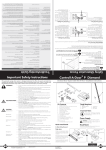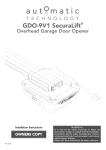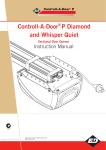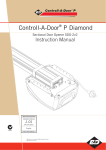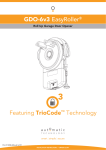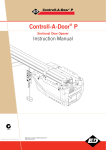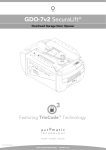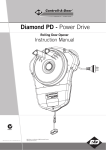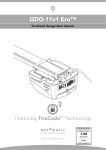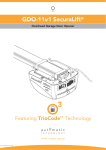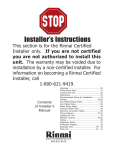Download Controll-A-Door S series Instruction manual
Transcript
S ® Controll-A-Door S Sectional Door Opener Instruction Manual Manufacturer’s Part # 79079 (Manual) V1.02 B&D Doors is a division of B&D Australia Pty Ltd ABN 25 010 473 971 www.bnd.com.au 2 Controll-A-Door ® S Instruction Manual Controll-A-Door® S Sectional Door Opener Safety Rules Default Settings & Specifications About Your Opener 03 04 05 Operating Controls 06 Kit Contents 08 Installation 09 C-Rail Attachment 09 Determine Door Type 10 Battery Back Up Installation 21 Mounting - Track Type Door 11 Solar Power System Installation 22 Mounting - Non-Track Type Door 12 How To Use Your Opener 24 Mounting Door Bracket & Arms 13 Transmitter Battery 24 14 Locking 24 14 Manual Release 24 Testing Safety Obstruction Force 15 Power Failure 24 Safety Obstruction Force Test 15 Safety Infra-red Beam 25 Adjusting Safety Obstruction Forces 15 Courtesy Light 25 16 Auxiliary Output 25 For Door Operation 16 Vacation Mode 25 For Courtesy Light Operation 16 Setting The Pet Mode Position 25 For Vacation Mode 17 Maintenance 26 For Auxiliary Output 17 Troubleshooting Guide 27 For Pet (Pedestrian) Mode 18 Parameters 28 Deleting All Transmitter Codes 18 Spare Parts 30 Mounting Wall Transmitter 18 Warranty 32 Programming the Opener Setting Travel Limits - Control Panel Coding Transmitters Accessories 19 Terminal Block Remote Aerial 19 19 Electric Key Switch 19 Safety Infra-red Beam 20 Controll-A-Door ® S Instruction Manual Safety Rules Please read these important safety rules These safety alert symbols indicate a personal safety or property damage instruction exists. READ THESE INSTRUCTIONS CAREFULLY. This automatic garage door opener is designed and tested to offer safe service provided it is installed and operated in strict accordance with the following safety rules. Failure to comply with the following instructions may result in death, serious personal injury or property damage. CAUTION: If your garage has no pedestrian entrance door, an emergency access device should be installed. This accessory allows manual operation of the garage door from outside in case of power failure. Position the Garage Door Opener so that the power plug is accessible when inserted into the power outlet (EN 60335-1). This opener should be installed in accordance with relevant Australian Standards. Do not allow children to play with door controls. Keep transmitters away from children. Watch the moving door and keep people away until the door is completely opened or closed. Activate the opener only when the garage door is in full view, free of obstructions and with the opener properly adjusted. Keep the garage door balanced. Sticking or binding doors must be repaired. Garage doors, door springs, brackets and their hardware are under extreme tension and can cause serious personal injury. Do not attempt any garage door adjustment. Do not use if repair or adjustment is needed. Call for professional garage door service. Install the optional wall transmitter in a location where the garage door is visible, but out of the reach of children at a height of at least 1.5m. Do not wear rings, watches or loose clothing while installing or servicing a garage door opener. This opener is not suitable for commercial, industrial or common entry applications. To avoid serious personal injury from entanglement, remove all unnecessary ropes or chains and disable any equipment such as locks which are not needed for powered operation. Installation and wiring must be in compliance with your local building and electrical codes. Connect the power cord only to properly earthed mains. If an extension lead must be used, make sure it is a 3-core lead and approved to 7 amp capacity. If the power cord is damaged, it must be replaced by the manufacturer, its service agent or a similarly qualified person in order to avoid a hazard. This opener is a plug in domestic appliance and is designed for indoor use only. It must be installed in a dry position that is protected from the weather. The opener is not intended for use by young children or infirm persons without supervision. WARNING! It is vital for the safety of persons to follow all instructions. Save these instructions. Disconnect electric power to the garage door opener before removing covers. Doors requiring over 400N of force to move must have Safety Infra-red Beams fitted. B&D Doors to the extent that such may be lawfully excluded hereby expressly disclaims all conditions or warranties, statutory or otherwise which may be implied by laws as conditions or warranties of purchase of a B&D Garage Door Opener. B&D Doors hereby further expressly excludes all or any liability for any injury, damage, cost, expense or claim whatsoever suffered by any person as a result whether directly or indirectly from failure to install the B&D Garage Door Opener in accordance with these installation instructions. © Copyright 2009 B&D Doors D Power Drive : Instruction Manual 3 4 Controll-A-Door ® S Instruction Manual Default Settings & Specifications Factory default settings Default Step Minimum Maximum Courtesy light time 3 minutes 10 Sec in battery backup mode - 3 minutes 10 Sec in battery backup mode- 3 minutes 10 Sec in battery backup mode- Obstruction force margin 0.7 amps 0.1 amps 0 2.0 amps Technical specifications Power supply 230V - 240Va.c. 50Hz Transformer rating 24Vd.c. Standby power 2.2 Watts Motor power 100 Watts Motor type 24Vd.c permanent magnet Shuttle travel distance in the C-Rail 2.7m approx. (standard)* Maximum shuttle travel distance in the C-Rail 3.750 m (with one extension)* Maximum door opening: Width: Height: Weight: 5500mm (16.5m2) 2150mm 100kg Minimum headroom 25mm Short term peak force 700N (70kg) Lift force 450N (45kg) Nominal force 150N (15kg) Receiver type UHF Multi-frequency FM Receiver Receiver code storage capacity 8 X 4 button Transmitter Codes Transmitter frequency 433.47, 433.92, 434.37 MHz Coding type Tri-Tran™ Number of code combinations Over 4.29 billion random codes Code generation Non-linear encryption algorithm Transmitter battery CR2032 (3 Volts) Courtesy light Festoon style lamp 24 volts 15 watt Controller fuse 10A slow blow *The actual travel of the door depends on configuration of the connecting arms. Note: Intermittent operations may occur in areas which experience very strong winds. The strong wind puts extra pressure on the door and tracks which may in turn intermittently trigger the safety obstruction detection system. Controll-A-Door ® S Instruction Manual About Your B&D Opener Thank you for choosing a Controll-A-Door® S automatic garage door opener, designed and developed in Australia by B&D Doors. Battery Back Up The technically advanced construction of this opener ensures you enjoy the following benefits: In case of a power failure the opener does not lose the transmitter codes or limit settings. Warranty Optional Battery Back Up or solar power is available. Memory Retention Five (5) year/10,000 cycles full parts and labour warranty on motor, electronics and mechanical components of the opener when installed by an Approved B&D Dealer (conditions such as annual garage door servicing apply). Soft Start/Soft Stop Tri-Tran Frequency Hopping Technology Manual Release Every time a transmitter is used, it simultaneously sends a signal over three different frequencies, reducing the chance of interference from other radio frequency sources. Code Hopping Technology Every time a transmitter is used a new security code is generated from over 4.29 billion possible code combinations. This greatly enhances the security of the system and makes “code grabbing” a thing of the past! Multi-Channel Transmitter Multi-channel transmitters allow you to operate other devices such as an adjoining garage door or automated gate from the same handy unit. Warranty Expired Indicator The opener eases into and out of each cycle making for smoother and quieter operation, as well as reducing wear and tear on the door and opener. The manual release handle allows the door to be operated by hand in the event of a power failure. Self Locking There is no need to manually lock your garage door, as the opener ‘positively’ locks the door when closed. Periodic Maintenance Indicator The SERVICE LED will illuminate to indicate that periodic maintenance is required. Contact your dealer/ installer for service. Service Fault Indicator Flashing LEDs on the control panel easily identify operational problems or service requirements. The opener will indicate that the number of cycles covered by the warranty has been reached by flashing the courtesy light 10 times after each operation. This flashing will continue for 20 cycles unless it is reset by pressing the SET button while the courtesy light is flashing. Dynamic Door Profiling S-ALPS (Semi Automatic Limits Positioning System) An external aerial can be connected for sites where radio reception is a problem. The S-ALPS system does away with manual adjustment of the door’s limits position using mechanical parts, such as cams and microswitches. Safety Reversing System The automatic safety reverse system significantly reduces the risk of death or serious injury if trapped by a closing door. The safety reverse force can be adjusted for environmental conditions such as windy areas. Courtesy Light The courtesy light automatically switches on for approximately three (3) minutes when operating the door. This can also be programmed to turn on and off from a transmitter. Changing door characteristics are automatically compensated for and “learnt” with each operation of the door. External Aerial Vacation Mode A transmitter can be programmed to disable the garage door opener radio receiver. This is ideal if the door is to be left idle for prolonged periods. Pet (Pedestrian) Mode A transmitter can be programmed to open the door partially to allow pets access to the garage. The door opening height is adjustable via a handheld programmer. Auxiliary Output You can program a spare button on your transmitter to operate this output, which can control items that use a momentary close switching mechanism. © Copyright 2009 B&D Doors D Power Drive : Instruction Manual 5 Controll-A-Door ® S Instruction Manual 6 Operating Controls 01. Terminal Block: 24V PWR is used to power devices such as Safety Infra-red Beams and external receiver (100 milliamp max). P.E(IR) input is used to connect to Safety Infra-red Beam. P.E(IR) 0V is a 0 volt connection for Safety Infra-red Beam. GND is a common -ve ground for accessories OSC is used for the connection of a wired switch (momentary contact). This switch can then be used to open, stop or close the door. Install the wall switch in a location where the switch is out of reach of children and the garage door is visible. AUX OUT This function allows the opener to operate other devices such as external lights, or an alarm system. 02. CODING LED (red) light flashes when a code is being stored or when a transmitter button is pressed. 03. DOOR CODE button is used for storing or erasing transmitter buttons for door operation 04. SERVICE LED (Yellow) indicates when the opener requires service or repairs. 05. SET button (Orange) is used during the installation phase together with the Open and MINUS (-) buttons to set the door limit positions. The Set button is also used to re-initialize the Opener. 06. OPERATE button (Yellow) is used during installation to test the open, stop and close cycles for the opener. The opener has to be initialised by the SET button to make the OPERATE button operable. 07. FORCE MARGIN SET Button: The obstruction force margin is set automatically during installation. The margin can be adjusted manually using the Force Margin Set button (White). Holding the Force Margin Set button and pressing PLUS (+) or MINUS (-) buttons will increase or decrease the amount of force. The Force Margin Set should only be used if environmental factors (wind, etc.) affect the door’s operation. 08. OPEN LIMIT LED (green) the LED is very helpful during installation. It illuminates and flashes when the door is opening and remains steady on when the open limit position has been reached. 09. PLUS (+) button (green) is used during installation to help set the open limit position. Pressing and holding this button will move the door in the open direction, releasing stops the door. NOTE: The safety obstruction detection is inoperable when the PLUS (+) button is used to move door. 10. CLOSE LIMIT LED (red) the LED is very helpful during installation. It illuminates and flashes when the door is closing and remains steady on when the close limit position has been reached. 11. MINUS (-) button (red) is used during installation to help set the close limit position. Pressing and holding this button will move the door in the close direction. Movement stops when the button is released. NOTE: The safety obstruction detection is inoperable when the CLOSE button is used to move door. 12. DATUM ADJUST SCREW is used during limits set up to indicate the mid point of the door’s travel. 13. 10A FUSE 14. PROG INPUT is used to connect the Handheld “PG-3” Programmer for editing control and receiver functions, accessing diagnostic tools, and activating special features and operating modes. 15. JP1 SOLAR CONNECTOR the shunt must be fitted for solar operation. 16. COURTESY LIGHT 15 watts 24 volts festoon type globe is used for courtesy light Controll-A-Door ® S Instruction Manual 7 Fig. 01 01 02 03 04 05 06 07 08 09 10 11 12 16 15 14 13 © Copyright 2009 B&D Doors D Power Drive : Instruction Manual Fig. 02 Controll-A-Door ® S Instruction Manual 8 Kit Contents Powerhead Unit (Fig. 03) Fig. 03 1 x Controll-A-Door® S powerhead 1 x Transmitter pack (Pack includes one TB-2 and one TB-4 keyring transmitters with batteries) 1 x Wall mount transmitter with battery 2 x Door attachment arms 1 x Accessory and hardware pack 1 x Installation Manual PLUS Single Piece C-Rail with Pre-Assembled Chain (Fig. 04) Fig. 04 NOTE: Chain in one piece rail has been tensioned by the factory. Do not adjust the tension of the chain. IMPORTANT NOTE: If a modification to the length of the track is required, the adjustment must be made from the powerhead end only. Controll-A-Door ® S Instruction Manual 9 Installation C-Rail Attachment Step 1 - Attach C-Rail to Powerhead Shaft Locate and insert the powerhead’s shaft into the C-Rail’s sprocket as shown in (Fig. 05). Fig. 05 Locate shaft into sprocket Step 2 - Secure C-Rail to Powerhead Fix the two track brackets as shown in (Fig. 06). Fix with the four screws supplied in accessory pack. Screw M4 X 8 2) t (x cke a r b ck Tra Fig.06 © Copyright 2009 B&D Doors D Power Drive : Instruction Manual 10 Controll-A-Door ® S Instruction Manual Determine the Door Type Step 3 - Determine the Door Type Proceed from Step 4 Determine which type of garage door you have as illustrated in (Fig. 7) to (Fig. 9). Track For a sectional (panel) door on tracks (Fig. 7) proceed with the installation from Step 4. Fig. 7 Door Sectional door with track For a one piece door on tracks (Fig. 8) proceed with the installation from Step 4. Proceed from Step 4 Track Fig. 8 Door One piece door with track Proceed from Step 8 on page 12 Door Fig. 9 One piece door without track For a one piece door without tracks (on springs) (Fig. 9) proceed with the installation from Step 8 (page 12). Controll-A-Door ® S Instruction Manual 11 Mounting - Track Type Door Step 4 - Determine Bracket Position a. b. c. Open the door and find the highest point of travel of the top door panel. Using a level, transfer this height to the wall above the door (Fig. 10) and mark a line 60mm above it. Determine the centre point on the wall above and on top of the door. Then draw two (2) lines extending 21.5mm from each side of the centre point. (Fig. 11) Level Level Track Track Fig. 10 Door Door Step 5 - Mounting the Wall Bracket a. b. c. Centre the bracket over the intersection of these two lines. Mark centres for at least two holes (Fig. 11). • Ensure a solid mounting point is behind these holes. Drill holes into the wall with an appropriate sized bit. Secure bracket to the wall using: IF CONCRETE OR BRICK - 8mm or 5/6 loxins or dynabolts. IF TIMBER - wood screw #20 or equivalent (minimum 50mm long). 3 4 .5 21 .5 21 Fig. 11 WARNING: Make sure concrete, brick wall or timber lintels are solid and sound so as to form a secure mounting platform. Drilled holes Step 6 - Attach the C-Rail to the Wall Bracket a. b. Attach the C-Rail assembly to the wall bracket with the 90mm long clevis pin and secure with the supplied snap pin (Fig. 12). Leave the powerhead in its packing box for protection during installation. Step 7 - Securing the Powerhead to the Ceiling a. b. c. d. e. Raise the powerhead from the packing box and support it in the horizontal position with a step ladder. Open the garage door. Rest the opener on the open door and use a scrap piece of wood to bring it to horizontal level. Line up the track perpendicular to the wall. Secure the perforated angle (not supplied) to the ceiling above where powerhead’s mounting holes will be once fully installed. A representative mounting is shown (Fig. 13). Connect the powerhead to the ceiling mounted perforated angle with M8x20mm screws and nuts. Strips should not extend more than 18mm below centre of powerhead mounting holes (Fig. 13). Fig. 12 Structural member Fig. 13 For an alternative mounting option, go to Step 10.1 WARNING: The opener must be securely fastened to structural supports, otherwise opener failure may ensue causing serious personal injury and/or property damage. © Copyright 2009 B&D Doors D Power Drive : Instruction Manual 12 Controll-A-Door ® S Instruction Manual Mounting - Non Track Type Door Centre of door WARNING: Make sure concrete, brick wall or timber lintels are solid and sound so as to form a secure mounting platform. Fig. 14 Step 8 - Determine the Door’s Centre a. b. Find the centre of the door and mark this location both above the door and on top of the door. Draw two lines 21.5mm either side of this (Fig. 14). Step 9 - Prepositioning the Opener a. b. c. Raise the door to open position. Rest the opener on the top edge of the door with end of the C-Rail against the wall (Fig. 18). Support the powerhead level with the lowest point of the open door (Fig. 15). NOTE: Do not slide C-Rail along the face of the door. Fig. 15 Step 10 - Mounting the C-Rail a. Step Ladder b. c. d. e. f. C rail g. Fig. 16 Highest point of door travel Door Step Ladder h. Close the door slowly. The C-Rail will be elevated by the top edge of the door as it moves. Stop the door when it is at its highest point of travel. Allow 25mm additional height for clearance between the door and the track (Fig. 16). Support the C-Rail in this position and close the door The height determined in Step 11(b) will be the height at which to mount the wall bracket. Centre the bracket along the line determined in Step 9. Using the bracket as a template, mark a minimum of two holes and drill with appropriate size bit. For a more secure fitting, the wall bracket can be anchored using more than two holes. Secure the bracket to the wall using: IF CONCRETE OR BRICK - 8mm or 5/6 loxins or dynabolts. IF TIMBER - wood screw #20 or equivalent (minimum 50mm long). Attach the wall bracket to the C-Rail with the 90mm long clevis pin (Fig. 17) and secure by a snap pin. Step 11 - Securing the Powerhead to the Ceiling a. b. Fig. 17 Secure the perforated angle (not supplied) to the ceiling above where powerhead’s mounting holes will be. See (Fig.13) for a representative mounting. Connect the powerhead to the ceiling mounted perforated angle with M8x20mm screws and nuts. Strips should not extend more than 18mm below centre of powerhead mounting holes (Fig. 13). WARNING: The opener must be securely fastened to structural supports, otherwise opener failure may ensue causing serious personal injury and/or property damage. Controll-A-Door ® S Instruction Manual 13 Mounting Door Bracket and Arms Step 11.1 - Alternative Mounting Option Drill hole at centre of track (recommended bolt size M6 or M8) The opener can be fastened to the roof by driving a bolt through the C-Rail into a structural timber support. The bolt head’s height must not exceed 6mm (Fig. 18). Fig. 18 Ceiling Step 12 - Mounting Door Bracket The door bracket comes in two parts. The bottom plate with two mounting holes is used on its own for one piece doors. For sectional doors, the top plate is placed over the bottom plate and is fixed with four (4) screws (Fig. 19). a. b. The height of bolt head must not exceed 6 mm Steel rail Shuttle assembly Mount the door bracket, or bracket assembly, on the door’s centre line one-third down the top panel (Fig. 19) using M6 or equivalent screws (not supplied), STEEL DOORS ONLY: Bracket can be welded in place. Fig. 19 NOTE: If in doubt about the door’s strength, reinforcement may be added to the door’s frame where necessary. Door damage may occur if the bracket is installed on a panel with insufficient strength. The opener’s warranty does not cover damage caused to the door and/or door panels. Step 13 - Attaching the Arms FOR SECTIONAL AND ONE PIECE DOORS WITH TRACK: a. Assemble the bent and straight arms with bolts and nuts supplied in the accessory pack (Fig. 20). Always use both bent and straight arms. b. Connect the assembled arm to the bracket and the disengaged trolley with clevis and snap pins. The angle “A” must be more than 10° (Fig. 20). 0 10 A Fig. 20 WARNING: Connecting the bent arm other way around may damage the door. FOR ONE PIECE DOORS WITHOUT TRACK a. Assemble the bent and straight arms as shown in (Fig. 21) with bolts and nuts supplied in the accessory pack. Always use both the bent and straight arms. b. Connect the assembled arm to the bracket and the disengaged trolley with clevis and snap pins. c. If installing on a door with a bad wave action, lengthening the arm will assist in reducing this effect. Fig. 21 IMPORTANT NOTE - If the manual release handle is more than 1.8 metres from floor level when the opener is installed, extend the handle to a height less than 1.8 metres. © Copyright 2009 B&D Doors D Power Drive : Instruction Manual Controll-A-Door ® S Instruction Manual 14 Setting Travel Limits IMPORTANT NOTE: The OPERATE button will not function until the open and close limit positions are set. NOTE: The door and shuttle must be engaged into the chain index. The door should be open approximately half way. Fig. 22 Note: If Safety Infra-Red Beam are to be used they must be installed before setting the travel limits. Step 14.1 - Setting Limits Positions Remove the controls cover to access the controls panel as shown in (Fig. 22). Replace it when setup is completed. Step 14.2 - Connect Power to the Drive unit Plug the power cord into a mains point and switch power on. The red CLOSE LIMIT LED will be flashing. WARNING: The safety obstruction detection system is inoperable while MINUS (-) and PLUS (+) drive buttons are being used and travel limits are not set. Fig. 23 Step 14.3 - Set the Datum Position a. b. Press and hold the MINUS (-) or PLUS (+) buttons to move the door to the halfway position. Ensure that the door, shuttle and chain index are engaged. Using a small screwdriver, turn the DATUM ADJUST screw until the STATUS LED comes on (Fig 23). Note: If the STATUS LED is already illuminated when the door is halfway up, turn the DATUM ADJUST screw until the light goes off, then turn back one notch to illuminate again. Step 14.4 - Set the Limits Positions a. Fig. 24 b. c. Press and hold the MINUS (-) button until the door reaches the desired close limit position. Single presses will inch the door closed (Fig 24). Press the SET button to store the close position into memory (Fig. 24). Press and hold the PLUS (+) button until the door reaches the desired open limit position. Single presses will inch the door open (Fig. 24). WARNING: The door will automatically close, open and close again once Step 12.4(d) is performed. Ensure that no persons or objects are in the door’s path. d. e. Press the SET button to store the open position into memory (Fig. 24). The door will now automatically close and open to calculate the safety obstruction settings. After this, the opener can be operated with the OPERATE button. Controll-A-Door ® S Instruction Manual 15 Testing Safety Obstruction Force CAUTION: Take care when testing the safety obstruction force. Failure to follow this warning can result in serious personal injury and/or property damage. Step 15.1 Test the Close Cycle a. b. c. d. Press the OPERATE button to open the door (Fig. 25). Place a piece of timber approximately 40mm high on the floor directly under the door (Fig 26). Press the OPERATE button to close door. The door should strike the object and re-open. Fig. 25 Step 15.2 Testing the Open Cycle a. b. c. Press the OPERATE button to close the door (Fig. 25). Press again to open the door. When the door reaches approximately half way, firmly grab the door’s bottom rail - the door should stop. If the door does not reverse readily when closing, or stop when opening, the force may be excessive and need adjustment, refer to Step 13.4. IMPORTANT WARNING: If the door is closing and is unable to re-open when obstructed, discontinue use. Do not use a door with faulty obstruction sensing. Repair fault and re-test before using. Fig. 26 Adjusting Safety Obstruction Force The safety obstruction force is calculated automatically and normally does not require adjustment. The only time the force may need to be adjusted is due to environmental conditions, such as areas that are windy, dusty or have extreme temperature changes that affect the operability and movement of the door. Step 15.4 - To Decrease Force Pressure a. b. WARNING: Doors requiring over 400N of force to move must have Safety Infra-red Beams fitted for safety. Step 15.3 - To Increase Force Pressure a. b. c. d. e. Press and hold the FORCE MARGIN SET button (Fig 25). While holding down the FORCE MARGIN SET button, press the PLUS (+) button. Each press will increase the force margin one step. The OPEN LIMIT LED will flash each time the PLUS (+) button is pressed to indicate an increase in force. Test the force again as per Steps 13.1 and 13.2. If the OPEN LIMIT LED flashes continuously when the PLUS (+) button is being pressed, this indicates that the maximum force setting has been reached. c. d. e. Press and hold the FORCE MARGIN SET button (Fig 25). While holding down the FORCE MARGIN SET button, press the MINUS (-) button. Each press will decrease the force margin one step. The CLOSE LIMIT LED will flash each time the MINUS (-) button is pressed to indicate a decrease in force. Test the force again as per Steps 13.1 and 13.2. If the CLOSE LIMIT LED flashes continuously when the MINUS (-) button is being pressed, this indicates that the minimum force setting has been reached. Step 15.5 - To Recall Factory Set Force a. b. Holding down the FORCE MARGIN SET button and the SET button for two seconds. Release both buttons. The default setting should now be recalled. © Copyright 2009 B&D Doors D Power Drive : Instruction Manual 16 Controll-A-Door ® S Instruction Manual Coding Transmitters Step 16.1 - Storing the Transmitter Code The opener can only operate from transmitters that have been programmed into its receiver. The receiver needs to learn the codes of any transmitter that will be used with the operator. Up to eight (8) codes can be stored in the receiver’s memory. Fig. 27 a. b. c. d. Press the DOOR CODE button and release. The DOOR CODE LED will illuminate to indicate the opener is in Code Learn mode. If a valid code is not stored within 15 seconds the opener will exit Code Learn (Fig. 27). Press the transmitter button (one of four) that you want to control the door. The DOOR CODE LED will begin to flash. Press the same transmitter button again. The DOOR CODE LED will illuminate for one second and then go out. The transmitter is now coded to operate the door - press the button to test. Step 16.2 - Setting the Transmitter to Operate the Courtesy Light Fig. 28 Although the courtesy light comes on with each operation of the opener, it may also be controlled by a transmitter without operating the door. a. b. c. d. Press the DOOR CODE button twice. The DOOR CODE LED will illuminate and the courtesy light will turn on to indicate that the light code learning is active (Fig. 28). Choose a transmitter button not already coded into the receiver. Press this button and the DOOR CODE LED will begin to flash. Press the same transmitter button again. The DOOR CODE LED will illuminate for one second and then go out. The transmitter is now coded to operate the light - press the button to test. Controll-A-Door ® S Instruction Manual 17 Coding Transmitters Step 16.3 - Setting the Transmitter to Operate Vacation Mode The opener can be programmed into a “Vacation Mode” where the opener will not respond to any transmitter except one preprogrammed unit. a. b. c. d. e. Press DOOR CODE button three times. The DOOR CODE LED will illuminate and the courtesy light will flash slowly (once every two seconds) to indicate Vacation learning mode is active. (Fig. 29) Choose a transmitter button not already coded into the receiver. Press this button and the DOOR CODE LED will begin to flash. Press the same transmitter button again. The DOOR CODE LED will illuminate for one second and then go out, and the courtesy light will also switch off. This indicates the code has been stored (Fig. 29). To activate Vacation Mode, close the garage door and press the coded button transmitter for 5 seconds. The DOOR CODE LED will illuminate to indicate that the opener is in Vacation Mode. To exit Vacation Mode press the transmitter button momentarily until the DOOR CODE LED turns off. Fig. 29 Fig. 30 Step 16.4 - Setting the Transmitter to Operate the Auxiliary Output It is possible to operate other devices (e.g. alarm systems) using one of the spare buttons of a multi-channel transmitter coded into the Auxiliary Output feature. a. b. c. Press DOOR CODE button four times. The DOOR CODE LED will illuminate and the courtesy light will flash quickly (twice per second) to indicate that learning mode for the Auxiliary Output is active. Choose a transmitter button not already coded into the receiver. Press this button and the DOOR CODE LED will begin to flash. Press the same transmitter button again. The DOOR CODE LED will illuminate for one second and then go out, and the courtesy light will also switch off. This indicates the code has been stored (Fig. 30). © Copyright 2009 B&D Doors D Power Drive : Instruction Manual 18 Controll-A-Door ® S Instruction Manual Coding Transmitters Step 16.5 - Setting the Transmitter to Operate Pet (Pedestrian) Mode The opener can be programmed into a “Pet Mode” where the door opens partially to allow pets to enter/exit the garage: Fig. 31 a. b. c. d. Press the DOOR CODE button five times, the DOOR CODE LED will illuminate and the courtesy light will flash quickly (twice per second) to indicate learning mode for Pet Mode is active. Choose a transmitter button not already coded into the receiver. Press this button and the DOOR CODE LED will begin to flash. Press the same transmitter button again. The DOOR CODE LED will illuminate for one second and then go out, and the courtesy light will also switch off. This indicates the code has been stored. This indicates the code has been stored (Fig. 31). The opening height of the door for pet position can only be changed with universal programmer. Step 16.6 - To Erase Programmed Codes Fig. 32 Fig. 33 If the DOOR CODE button is pressed and held for 6 seconds the DOOR CODE LED will blink rapidly for one second to indicate that all programmed codes have been erased. (Fig. 32) Step 16.7 - Installation of the Wall Mounted Transmitter a. b. c. Mount the transmitter in a convenient location, yet out of reach of children and at least 1.5m off the ground (Fig. 33). Make sure the door is visible from this location. To set the transmitter codes refer to Step 16.1. Controll-A-Door ® S Instruction Manual 19 Accessories Step 17.1 - Terminal Block A variety of wired accessory items can be connected to the terminal block such as Safety Infra-red Beams, electric key switch and more (Fig. 34). The terminal block also features auxiliary output for controlling other devices from your transmitter. These can include: an alarm system, external lighting, or an automatic gate. Terminal connections from top down are as follows: 1. 30V PWR (+ve) 2. P.E (Safety Infra-red Beam input) 3. P.E 0V (0V for Safety Infra-red Beam) 4. GND (Common -ve ground for accessories) 5. OPERATE (Open/Stop/Close trigger) 6. AUX OUT (Auxiliary output trigger) PWR PE (IR) PE (IR) 0V Fig. 34 GND OSC (OPERATE) AUX Step 17.2 - Remote Aerial (Part No 062177) Some sites cause poor radio reception. Particularly problematic areas are those where there is a large amount of metal, like an all steel garage, or an underground car park with large masses of steel reinforced concrete. These issues, and others, can create radio reception issues. Poor radio reception will be noticed by a reduction in the operating range of the transmitters. 30V PWR P.E P.E 0V GND OPERATE AUX OUTPU You can evaluate whether fitting an external aerial will benefit as follows: test the maximum operating range of the transmitter • with the garage door closed; then test the maximum operating range of the transmitter • with the garage door open. If the range improves when the door is open you can install a remote aerial kit to improve reception. Mount the aerial to a suitable location on the outside of the garage. Similar to a television aerial, the better the mounting position the better the reception will be. Where possible, mount the aerial as high as possible, away from masses of metal and in a line of sight position to where you normally use your transmitter. Step 17.3 - Electric Key Switch (Part No 062738) An electric key switch provides an alternative to using a transmitter. Each key turn cycles through an open/stop/close function. The electric key switch is also an external release mechanism - ideal for garages only with one entrance. To connect the switch to the opener’s terminal block refer to (Fig. 35) and the Electric Key Switch’s instruction sheet. © Copyright 2009 B&D Doors D Power Drive : Instruction Manual Fig. 35 20 Controll-A-Door ® S Instruction Manual Accessories IMPORTANT NOTE - The Safety Infra-red Beam must be installed and connected before the travel limits are set - See Step 12. 3 4 WARNING: Doors requiring over 400N of force to move must have Saftey Infra-red Beams fitted for safety. 5 Fig. 36 Step 18 - Safety Infra-red Beam Safety Infra-red Beam extends across the door opening. This Safety Infra-red Beam is designed to detect an obstruction while the door is closing and to send a signal to the door opener to reverse or stop the door movement. 2 6 1 Step 18.1 - Fitting Safety Infra-red Beam a. b. c. a. Fig. 37 b. Attach the mounting bracket (4) to adjustment bracket (3) with the pan head screw (6) (supplied) (Fig. 36). Attach the PE 2000TS bracket (2) to Safety Infrared Beam transmitter (IR-200TS-TX) with four taptite screws (m3x5) and attach the other side to adjustment bracket (3) with the pan head screw (6) (supplied). Repeat steps a and b to assemble the Safety Infra-red Beam ( IR-200TS-RX). Locate the Safety Infra-red Beam in a strategic location in the gateway. B&D recommend that the sensor is placed 150 mm above the floor level. Connect as per the wiring diagram (Fig. 38). Use 2.2 kilo ohm resistor with the colour code red, red, red and gold on the Safety Infra-red Beams receiver between the V- and NC terminals as shown in (Fig. 38). Step 18.2 - Alignment a. b. R1 c. R1 Fig. 38 R1=2.2K OHM RED,RED,RED,GOLD .25WATT 5% TOLERENCE RESISTANCE BLACK BLACK BLACK YELLOW RED RED RED BLACK YELLOW Power up the Safety Infra-red Beam. The green LED on the transmitter and red LED on the receiver should turn ON to indicate power is present. If the receiver is connected to power and the red LED is on while the green LED is on, the transmitter and receiver are not aligned. Make horizontal and/or vertical (Fig. 37) adjustment on the transmitter and/or receiver until the red LED turns off on the receiver, indicating alignment. WARNING: When using Safety Infra-red Beam, the doorway must be clear of all obstructions and persons at all times. The location of the beams and manner in which it is installed might not give safety protection at all times. Check to make sure that the height of the beam and type used give maximum protection possible. V- IN V+ P.E BEAM WARNING: Install the Safety Infra-red Beam as per diagram in Fig. 38. Tampering with the Safety Infra-red Beam could result in serious personal injury and/or property damage and will void the warranty. Controll-A-Door ® S Instruction Manual 21 Battery Back Up Installation Fig. 39 Step 19 -Battery Back Up (optional) The opener has provision for a Battery Back Up kit that allows continued operation of the door in the absence of mains power. Step 19.1 -Installation 1. 2. 3. 4. 5. 6. Disconnect power to the opener. Remove screws and swing the cover open (Fig. 39). Use battery pack # 1. Mount battery pack and secure with item 11 and 13. Mount the pcb support item16 on to chassis with item 12 and install the SBY-3 item 8 Charger Board on to the pcb support with item 14 screws. Feed the 2-wire battery harness item 10, through the grommet on the base plate and connect to the SBY3. Feed the charger harness from SBY-3 to the control board. Plug the 4-pin connector marked “SBY-3” onto the control board. Warning: After the next step the opener may become active (even when power is off) due to a residual charge in the batteries. 7. Connect item 5 and 10 together (Fig 39). 8. Reconnect the power. Step 19.2 -Testing Battery Back Up 1. 2. Press either the OPERATE button or transmitter to activate the opener. Whilst the door is in motion disconnect mains power - the opener should continue to operate. Note: Wait for the door to complete its travel before proceeding to the next step 3. 4. Press either the OPERATE button or transmitter to activate the opener. Whilst the door is in motion re-connect power. The door should complete the cycle as normal. Step 19.3 -Troubleshooting If door stops or moves very slowly under battery power, then the batteries may have little to no charge. To remedy this connect mains power and leave the batteries to charge. The batteries may take 24 to 48 © Copyright 2009 B&D Doors D Power Drive : Instruction Manual Controll-A-Door ® S Instruction Manual 22 Accessories SmartSolar™ Installation WARNING: Do not connect batteries until Step 20.3 S S Step 20.1 - Mount the Charger Board a. b. Fig. 40 c. d. e. f. g. Disconnect power to the opener. Swing open the light diffuser and controls cover. Remove screws marked “S” above in Fig. 40 and lift up the main cover. Remove the transformer and mains power cable. Mount the PCB support with two screws .Secure the SCG01-200 charger board on to PCB support with 3 screws. (Fig. 41). Plug the solar charger Board’s three wire harness (red/ yellow/black) into the control board’s “SBY-3” connector on the control board. Plug the Charger Board’s white one wire harness into the control board’s “24vac in” connector. Plug the solar shunt (supplied) onto the control board’s “JP1” solar connector. IMPORTANT Warning: Do not connect battery or solar panel polarity incorrectly - this will result in serious damage to components. Fig. 41 Step 20.2 - Connect the Solar Panel a. b. c. Warning: During Step 20.3 the opener will become active. Black Yellow Red Fig. 43 Step 20.3 - Mount & Connect the Battery e Whit ttery) ire W ck ire a l B dW e R Red (From Ba ttery) Black (From Ba Red (From Solar P anel) olar Panel) Black (From S Fig. 42 Mount the solar panel as outlined in the SmartSolar™ Installation Manual. Feed the Solar Panel’s cable through black grommet located on the top of the metal plate. Connect the red wire to the Charger Board’s “SOLAR+” connector, and the black wire to the “–SOLAR” connector (Fig. 42). a. b. c. d. e. f. Mount the Battery Box close to the opener. Feed the 2-core 18awg gauge cable (supplied) through the Battery Box’s grommet. Connect the red wire to the Battery Box’s “+” terminal, and the black wire to the “–” terminal (Fig. 43). Feed the other end of the battery cable through the Drive unit’s black grommet located on the metal plate. Connect the red wire to the Charger Board’s “BAT+” connector, and the black wire to the “–BAT” connector (Fig. 42). Refit the light diffuser and main cover. Step 20.4 - Re-setup and Test the Opener a. b. Setup travel limits and code transmitters. Press either the OPERATE button or use a transmitter to operate the opener. Controll-A-Door ® S Instruction Manual How to use your opener For maximum efficiency of your opener, your garage door must be in good operating condition. An annual service of your garage door by an Approved Dealer is recommended. CAUTION - Activate the opener only when the door is in full view, free of obstructions and with the opener properly adjusted. No one should enter or leave the garage while the door is in motion. Do not allow children to play with or near the door. Fig. 44 WARNING! This opener is a mains voltage plug-in domestic appliance and there are no user serviceable parts inside this opener. Transmitter • • • • To operate the opener, press the programmed transmitter button until your door begins to move (usually 2 seconds). Make sure you can see the door when you use the transmitter. If you are in a vehicle you should aim the transmitter through your windscreen (Fig. 44). Check that the door is fully closed before you drive away. If you press the transmitter whilst the door is moving the door will stop. The next press of the transmitter will move the door in the opposite direction. The transmitter may also be programmed to operate the following features (see Pages 16 to 18 for full details): • to turn the courtesy light on and off without operating the door, • to activate the Auxiliary Output, • to put the door into “Pet Mode” where it opens partially to allow pet access to the garage, and/or • to put the garage door opener into “Vacation Mode” where it will not respond to any transmitters. NOTE: Additional transmitters may be purchased at any time. © Copyright 2009 B&D Doors D Power Drive : Instruction Manual 23 24 Controll-A-Door ® S Instruction Manual How To Use Your Opener Removing the Battery From the Transmitter (Battery Type: 3V Lithium Battery CR2032). Use a non-metallic object (e.g. pen) to remove the battery. (Fig. 45) Inbuilt Locking Facility DO NOT lock your door when your opener is engaged as it has inbuilt locking facility. With the opener engaged your door will be locked whether the power is on or off. Fig. 45 Manual Door Operation CAUTION: when operating the manual release while the door is open. The door may fall rapidly due to weak or broken springs, or due to being improperly balanced. (AS3350) CAUTION! Do not disengage the opener to manual operation with children/persons or any objects including motor vehicles within the doorway. To disengage the opener from the door (preferably with the door in the closed position), pull down on the string handle on an angle towards the door. This will allow you to manually open or close the door. To re-engage the opener pull the string handle away from the door. WARNING! When the opener is manually disengaged, the door is no longer locked. To lock the door manually, re-engage the opener after the door is closed. Power Failure When there is a power failure, the opener will be unable to automatically open or close your garage door. To use your door whilst there is no power you will need to disengage the opener and use the door manually – see Manual Operation above. REPLACE BATTERY WITH CR2032 ONLY Controll-A-Door ® S Instruction Manual How To Use Your Opener Safety Infra-red Beam A Safety Infra-red Beam Kit may be fitted to this opener. • When this option is fitted, the operation of this device is such that if an object (i.e. car, child, etc.) blocks the Safety Infra-red Beam, then the garage door opener will not close the door automatically. • If the Safety Infra-red Beam is fitted but not operating correctly, then the door once opened automatically, will not close automatically. The door may be closed by reverting to manual operation – see Manual Operation. open partially. See Step 16.5 for more information. Courtesy Light The Courtesy Light will illuminate for approximately three (3) minutes each time the door is operated automatically. Spare buttons of a multi-channel transmitters can be programmed to turn the light on and off by remote control. See Step 16.2 for more information. Auxiliary Output This function allows the opener to operate other devices such as external lights or an alarm system. To use this function, a spare button of a multi-channel transmitter must be programmed to operate the Auxiliary Output feature. See Step 16.4 for more information. Vacation Mode The radio receiver of the garage door opener can be turned off to all but one transmitter via Vacation Mode. Whilst in vacation mode the opener will not respond to any transmitter. To activate the Vacation Mode facility, see Step 16.3. NOTE - program only one button to control “Vacation Mode”. This will reduce the possibility of accidental activation of this feature. Pet (Pedestrian) Mode A transmitter can be programmed to open the door partially to allow pet access to the garage. To activate Pet Mode press the transmitter button that has been programmed for Pet Mode - the door will © Copyright 2009 B&D Doors D Power Drive : Instruction Manual 25 26 Controll-A-Door ® S Instruction Manual Maintenance Maintenance The SERVICE LED will indicate the requirement for a service and/or adjustment. To reset the SERVICE LED when the door is serviced, reprogram the Door Travel Limits and the Door Travel Force – on completion of this programming the SERVICE LED will go out. Whilst your opener does not require any periodic maintenance, the door that it is fitted to does. Your garage door is a large, heavy, moving object and should be tested regularly to ensure it is in good condition. A poorly maintained door could cause fatal or serious injuries or serious damage to property. To ensure a long and trouble free life for your opener the following is recommended: Monthly • • Disengage the opener and manually operate the door: The door must be smooth to operate by hand. An operating force on the bottom rail should not exceed 150N (15kg) force. Each month check that the opener reverses when the door contacts a 40mm high object placed on the floor (AS3350). Refer to Testing the Safety System (Step 16). NOTE: If the door does not operate smoothly, call your nearest Approved Dealer. Yearly CAUTION: Frequently examine door, particularly cables, springs and mountings for signs of wear, damage or imbalance. Do not use if repair or adjustment is needed since a fault in the installation or an incorrectly balanced door may cause injury. (AS3350) Adjustments should only be carried out by experienced persons, as this function can be dangerous if not performed under strict safety procedures. WARNING! Failure to maintain your garage door may void the warranty on your garage door opener. Warranty Expired Indicator When the opener reaches the number of cycles covered by warranty the courtesy light will flash 10 times after each operation to indicate that the warranty has expired. This flashing will continue for twenty (20) operations unless the user acknowledges the warranty expiry indicator and stops the light from flashing. To stop the courtesy light flashing press the SET button while the light is flashing after an operation. B&D suggests that you contact your nearest Approved Dealer to perform an annual door service. Service Record Record any maintenance in the following table to assist in any warranty service. Date Service by Signature Invoice No. Amount Controll-A-Door ® S Instruction Manual Troubleshooting Guide Symptom Possible cause Remedy The opener does not work from the transmitter Garage door in poor condition e.g. springs may be broken Check the door’s operation - see monthly maintenance (Page 26) The opener does not have power Plug a device e.g. a lamp, into the power point and check that it is OK The battery in the transmitter is flat Replace the battery (Page 24) The opener has been put into “Vacation Mode” Turn off “Vacation Mode” (Page 17) The transmitter code has not been set See transmitter & code setting procedure (Page 16) The motor runs but the door does not move The opener is disengaged Re-engage the opener (Page 24) The transmitter range varies or is restricted Variations are normal depending on conditions e.g. temperature or external interference See instructions for correct use of transmitter (Page 23) The battery is flat or faulty Replace the battery (Page 24) Position of the transmitter in the motor vehicle Change the position (Page 23) Position of the aerial will not pick up the radio signal Install an external aerial kit – see Accessories (Page 19) The light does not work Light module is not inserted/ connected properly Check for correct connection otherwise contact your dealer for support The door reverses for no apparent reason This may occur occasionally from weather changes The opener automatically adjusts to compensate for changes, to adjust the force see (Page 15) If You Need a Service Call If the opener needs service please call the dealer who installed the garage door opener (for product assistance contact 13 62 63 within Australia). BEFORE CALLING you should have the following information to assist in providing the appropriate service: 1. 2. 3. 4. 5. Has anything happened since the opener last operated OK, e.g. a storm, a jolt to the door etc.? How easy is it to manually open and close the door? What model is the opener? Who installed the opener? When was it installed? Fault Indicator When a fault is detected the SERVICE LED will start to flash and a number of beeps will sound to indicate that there is a fault. The fault will be active each time an attempt is made to operate the door. Pressing the SET button will reset the opener. If the fault continues to be tripped contact an Approved Dealer for assistance. © Copyright 2009 B&D Doors D Power Drive : Instruction Manual 27 28 Controll-A-Door ® S Instruction Manual Parameters Door status indicators Door opener state OPEN LED (green) Open On Close Opening CLOSE LED (red) Beeper On Flashing Closing Flashing Door travel stopped Flashing Door obstructed when opening Flashing Door obstructed when closing Flashing Flashing Opener overloaded Alternating flashes Mains power interrupted Rapid flashes Beeps while door is moving Alternating flashes Button Function OPERATE Opens/stops/closes the door DOOR CODE Codes a transmitter button for operate function FORCE MARGIN SET & PLUS (+) Increases the obstruction force margin setting FORCE MARGIN SET & MINUS (-) Decreases the obstruction force margin setting FORCE MARGIN SET (then) SET Reloads the factory set default obstruction force margin setting (-) (for 6 seconds) Clears the door limits set positions. Limits then need to be reset SET (the power on) and hold until all LEDs are off Deletes control parameters excluding transmitter storage memory DOOR CODE press and hold until DOOR CODE LED starts flashing Deletes all transmitter storage memory SET & DOOR CODE (the power on) and hold until all LEDs are off Deletes all control parameters and transmitter storage memory Controll-A-Door ® S Instruction Manual © Copyright 2009 B&D Doors D Power Drive : Instruction Manual 29 60379 64053 16232 61733 10570 5 GEARD MOTOR ASSY 16V2 55RPM 6 HELICAL GEAR 59 - 1M CP 7 TIMING SUPPORT VP3 8 RATCHET TIMING ASSY 9 TAPTITE SCREW “P” M4x10 10361 65421 67575 71415 72127 62116 65440 64653 60276 61453 64698 64921 62941 63005 62950 71643 65790 18 TERMINAL BLOCK 500/02DS 19 CAP POLYFILM 0.1UF KX2 275VAC 20 MAIN COVER VP4 BK CADS SP AY 21 LIGHT DIFFUSER VP4 B&DSP 22 CONTROLS COVER VP4 SP TRD 23 GLOBE 24V/15W 15x44 24 C RAIL TRACK 77.8x31.8x3160_TSO1 25 SHUTTLE ASSY TS01 26 TENSION CHAIN ASSY-TS01 27 SPROCKET 12T-12.7_TS01 28 SPROKET SUPPORT _TS01 29 CHAIN INDEX V3 30 CHAIN 1/2”x1/8”(487 LINKS) W/2CL 31 CHAIN JOINT LINK 32 CHAIN CLIP 1M KIT 33 PIN 0890 62022 16 TRANSFORMER TDB-100-143 V2 KIT 17 PAN HEAD SCREW W/T.L.WASHER M3x14 71254 14057 15 TERMINAL BLOCK SHIELD 13 WIRE GUIDE VP3 14 SDO-3V1 C.B. DCBO7-1.01-100B 10504 64891 12 TAPTITE SCREW “S” RoHS PF THD M4x10 10380 14150 4 POWER CORD 1.5M W2P + IR 10503 65606 3 CORD GRIP GROMMET SB5P-2 11 TAPTITE SCREW “S” RoHS PF THD M4x8 65603 10 PAN SEPARATION HEAD SCREW M4x12 72005 2 GROMMET 101422 B&D Part No. 1 METAL CHASSIS VP4 Item # Description 43 STRAIGHT ARM 42 BENT ARM 41 TRACK BRACKET VP2 40 WALL BRACKET_TS01 39 DOOR BRACKET LOCATOR 38 DOOR BRACKET 37 PIN SNAP SSP 8 ZNU 31080 36 HEX SERRATION FLANGE NUT M8 35 HEX HEAD SCREW M8x25 34 CLEVIS PIN 0829 Item # Description 62790 62800 64592 62522 62515 62511 10720 10148 10110 62551 B&D Part No. 30 Controll-A-Door ® S Instruction Manual Spare Parts List Controll-A-Door ® S Instruction Manual 31 Fig. 46 © Copyright 2009 B&D Doors D Power Drive : Instruction Manual 32 Controll-A-Door ® S Instruction Manual Warranty 1. Definitions ‘B&D’ means (a) in Australia - B&D Doors of 17 Oasis Court, Clontarf, Queensland, 4019, a division of B&D Australia Pty Ltd (ABN 25 010 473 971), or (b) in New Zealand - B&D Doors NZ Ltd of 70 Allens Road East Tamaki Auckland, which is a subsidiary of B&D Australia Pty Ltd. ‘Purchaser’ means the purchaser of the Opener. ‘Opener’ means the ‘Controll-A-Door® Sectional Door Opener’ ‘Approved Distributor’ means a reputable reseller of B&D products purchasing on an open account from B&D, for the purpose of supplying and installing those products to end users. ‘Major Components’ means all components of the Opener that make up the powerhead, including and track assembly, if any, that is attached to a garage door. ‘Ancillary Components’ means all components of the Opener which are not Major Components. ‘Manufacturer’s Written Instruction Manual’ means the instruction manual provided with the Opener. 2. This warranty applies to every sale of an Opener to a Purchaser by B&D or its Approved Distributor, and is the only warranty given on behalf of B&D. 3. B&D warrants that it will, at its option, either repair or replace any defects: (i) in materials or workmanship in the Opener, subject to the following: (a) for Major Components of the Opener that are installed by B&D or an Approved Distributor the warranty shall be valid for a period of five (5) years or 10,000 cycles (whichever occurs first); (b) for Major Components of the Opener that are not installed by B&D or an Approved Distributor the warranty shall be valid for a period of twelve (12) months, provided that all costs of disconnection, reinstallation and freight shall be borne by the Purchaser (c) For Ancillary Components of the Opener the warranty shall be valid for a period of twelve (12) months. (ii) in installation for a period of twelve (12) months from the date of installation where the Opener has been installed by B&D or its Approved Distributor. 4. The warranties provided in clause 3(i) shall only apply to an Opener which is being used under normal use and service in accordance with the Manufacturer’s Written Instruction Manual and are limited to the repair or replacement, at B&D’s option, of any defective Opener or parts thereof. 5. The warranty provided in clause 3(i) shall apply from: (i) the date of delivery of the Opener by B&D; or (ii) the date of installation of the Opener by B&D or one of its Approved Installers; or (iii) the date of purchase of the Opener by the Purchaser; whichever is the later. 6. (i) Where the Opener has been sold to the Purchaser by B&D, the Purchaser shall make all warranty claims hereunder directly with B&D; (ii) Where the Opener has been sold to the Purchaser by an Approved Distributor, the Purchaser shall make all warranty claims hereunder directly with the Approved Distributor. 7. The Purchaser will pay for any service call made by B&D or an Authorised Distributor where such a call is made for the purpose of adjustment (as described in the Manufacturers Written Instruction Manual) and not for rectification of a defect pursuant to the warranty hereunder. 8. (i) The Purchaser shall be responsible for any expense incurred by B&D or an Approved Distributor in ensuring that the Opener is readily accessible for any repair work carried out under this warranty. Where an Opener is installed outside a capital city metropolitan area and a warranty claim is made pursuant to this warranty, any travelling expenses and costs of transporting the Opener, incurred by B&D or its Approved Distributor, shall be borne by the Purchaser. Controll-A-Door ® S Instruction Manual Warranty 9. Subject to paragraph 12 hereof; (i) the obligations of B&D under this warranty are limited to those contained herein and such warranties are expressly in lieu of all other warranties, express or implied, including any implied warranty of merchantability or fitness for a particular purpose and notwithstanding any course of dealing between the parties or custom and usage in the trade to the contrary. (ii) B&D shall not be subject to nor incur and the Purchaser releases B&D from any claim or liability (including consequential loss or damage and loss or use or profit) by reason of delay, defective or faulty materials or workmanship, negligence or any act, matter or thing done, admitted or omitted by B&D. 10. Subject to Clause 12 hereof, this warranty does not extend to and B&D will be relieved of all obligations, responsibilities and liabilities (direct or consequential) in the event that defects in manufacture of the Opener are directly or indirectly in the opinion of B&D due to or result from: (i) being fitted to any door or other closing device which is not of the type or condition defined in the Manufacturers Written Instruction Manual as suitable for installation of the Opener. (ii) Lack of proper maintenance or care – failure to have the door serviced annually may void this warranty. (iii) Incorrect and unreasonable use. (iv) Faulty installation or adjustment of the Opener or door to which the Opener is connected where such installation or adjustment is not carried out by B&D or one of its Approved Distributors. (v) Failure to observe any instructions or directions provided with the Opener or given to the Purchaser by B&D or an Approved Distributor. (vi) Modifications or repairs made or attempted to be made by any unauthorised person. (vii) Faulty electrical wiring of structures to which the Opener is affixed. (viii) Radio (including citizen brand transmissions) or other electronic interference. (ix) Water damage, including effects from rust and corrosion. (x) Use with doors locked. 11. The warranty contained in Clause 3 does not cover batteries or globes and B&D shall not be liable for any defect, malfunction or failure of such items. 12. It is expressly provided that the warranties or any terms and conditions of them or other statement contained in this document or other literature given to the Purchaser shall not be read or applied so as to purport to exclude, restrict or modify or have the effect of excluding, restricting or modifying the application in relation to the supply of the Opener of all or any of the provisions of Divisions 2 and 2A of Part V of the Trade Practices Act, 1974, or the Consumer Guarantees Act 1993 if the purchase is a ‘consumer’ and purchased the opener in New Zealand, (“The Act”) as amended or the exercise of a right conferred by such a provision or any other condition or warranty implied by any relevant State Act or Territorial Ordinance or by the general law and which by law cannot be excluded, restricted or modified provided that to the extent that the Act permits B&D to limit its liability for a breach of condition or warranty implied by the Act, B&D’s liability for such breach shall be limited to the payment of the cost of replacing the Opener or acquiring an equivalent Opener or repairing the Opener. 13. This warranty shall be governed by and construed in accordance with Australian law if the opener was purchased in Australia, or New Zealand law if the opener was purchased in New Zealand. 14. Upon making a claim under this warranty the purchaser must produce proof of the date of purchase, together with the details set out below: Purchased From: Installed By: Installed Date: The Purchaser shall complete this certificate and keep it together with a copy of the receipt of purchase in a safe place – production of such information will assist the handling of a claim made under this warranty. © Copyright 2009 B&D Doors D Power Drive : Instruction Manual 33 34 Controll-A-Door ® S Instruction Manual Optional Accessories There is a range of additional accessories for your added convenience and security. • Safety Infra-red Beams - Part No 062736. Gives additional protection if the door is closing onto your property or person. Simply breaking the beam “stops” the door! Must be fitted if the Auto-Close feature is operational. • Keyring Transmitter - Ideal for personal use when entry into the house may be via the garage. • Transmitter Wall Button - Part No 062733. Allows you to operate the opener within 10 metres of the door. Ideal for mounting inside the house. • Combo Access Kit - Part No 062738. Keyswitch function will open the door without a transmitter. Can be used to manually disengage the opener, and recommended when the garage door is the only access to the garage. • Remote Aerial Kit - Part No 062177. For sites where radio range may be reduced. Contact your Approved Dealer for installation of these accessory items. When installing any accessories, always follow the instructions included with the product. Only B&D accessories purchased from an Approved Dealer offer the highest quality and assure you of trouble free opener operation. Controll-A-Door ® S Instruction Manual © Copyright 2009 B&D Doors D Power Drive : Instruction Manual 35 QLD Office: 17 Oasis Court, Clontarf 4019. Ph: (07) 3883 0200 NSW Office: 34-36 Marigold St, Revesby 2212. Ph: (02) 9722 5555 VIC/TAS Office: 147-153 Canterbury Road, Kilsyth 3137. Ph: (03) 9237 7766 SA Office: 23 Frederick Road, Royal Park 5014. Ph: (08) 8440 4747 WA Office: 96 Mulgul Drive, Malaga 6062. www.bnd.com.au Ph: (08) 9247 8777 NZ Office: 70 Allens Road, East Tamaki, Auckland. www.bnd.co.nz Ph: (09) 273 8600 B&D Doors is a division of B&D Australia Pty Limited - ABN 25 010 473 971 ©Copyright January 2008 B&D Doors. All Rights Reserved. ® and TM are registered trademarks of B&D Australia Pty Ltd. In an ongoing commitment to product quality B&D Doors reserve the right to change specifications without notice. E&OE. www.bnd.com.au




































